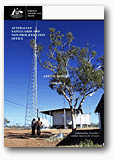


Annual Report 1998-99 |
 |
PROGRAM ACTIVITIES
ASNO’s activities in 1998–99 are described and evaluated in the following sections.
Activities are described in relation to particular tasks, and grouped according to the output to which they relate (see summary of outcomes and outputs).
OUTPUT B
Development and implementation of bilateral safeguards measures that ensure nuclear material and items exported from Australia remain in peaceful use.
Milestone B1
Internationally agreed standards for physical protection of nuclear material are applied to all AONM.
Activities
ASNO continued its practice of requiring exporters to adopt specific procedures to ensure appropriate levels of physical protection for shipments of uranium ore concentrates (UOC) from Australia to the port of unloading overseas. These procedures included checking on the physical condition of the containers and verifying the container and seal numbers at each port of unloading or transhipment.
ASNO has played a role over past years in the development of international standards for physical protection of nuclear material, and uses suitable opportunities to promote their universal adoption. For example, from 27-29 October 1998, Mr Bellinger, Head, Nuclear Materials Accountancy and Control (NMAC) Section, participated in an Experts Meeting at the IAEA in Vienna that reviewed IAEA document INFCIRC/225/Rev.3, ‘The Physical Protection of Nuclear Material’. The meeting of national experts produced Revision 4 of INFCIRC/225, entitled ‘The Physical Protection of Nuclear Material and Nuclear Facilities’.
Performance Assessment
Reporting by conversion facilities, safeguards authorities and shipping agencies confirms that all AONM shipments from Australia safely reached their destinations. The specified physical protection measures effectively contributed to this outcome.
AONM in countries with which Australia has concluded nuclear safeguards agreements is accounted for in accordance with procedures and standards prescribed by relevant agreements.
Activities
Exports of Uranium Ore Concentrates (UOC)
Between 1 July 1998 and 30 June 1999 there were 38 shipments of UOC from Australia. These were made by Energy Resources of Australia Ltd (ERA), Ranger Mine, Northern Territory and WMC (Olympic Dam Corporation) Pty Ltd, South Australia. Exports totalled 5,989 tonnes of U3O8 as UOC; export earnings were over $287 million.
The UOC were shipped to conversion facilities in the United Kingdom, the United States, France and Canada. ASNO notified each export to the safeguards authorities in relevant countries. In each case, receipt was confirmed to ASNO by those safeguards authorities. ASNO also notified the IAEA of each export. In the case of exports to Canada, notifications were made pursuant to Article 35(a) of Australia’s NPT safeguards agreement with the IAEA. In the case of exports to nuclear-weapon States, notifications were made under the IAEA’s Voluntary Reporting Scheme, and also under the Additional Protocol.
The shipper’s weight for each consignment was entered on ASNO’s record of the relevant country’s inventory of AONM. These weights, subject to amendment by measured Shipper/Receiver Differences, are the basic source data for ASNO’s system of accounting for AONM throughout the international nuclear fuel cycle.
Operation of bilateral agreements
The reports from ASNO’s counterpart organisations have generally been provided in a timely fashion and in the agreed format. This year, the report from Canada for 1998 was not received before going to press. The delay was attributed to the electric power generation utility, Ontario Hydro, being broken up into five separate entities. This caused a delay in the new company (Ontario Power Generation) reporting figures to the Atomic Energy Control Board of Canada, ASNO’s counterpart organisation.
During May and June 1999, Mr Bellinger and Nuclear Materials Accountant, Mr Doulgeris, held discussions with ASNO’s counterpart organisations in the United States, Canada, Japan, the Republic of Korea, the United Kingdom, France, Euratom, Switzerland, Sweden and Finland. Accounting figures were reconciled and issues of concern were discussed. Reconciliation of inventories presented few problems, while progress was made in improving the bilateral safeguards system and exchanges of experience were useful. ASNO is discussing transparency issues with Euratom, while maintaining close liaison and consultation with the four EU Member States with which Australia has separate bilateral agreements (Finland, France, Sweden, and the United Kingdom).
Laser enrichment technology
The laser enrichment R&D being undertaken by Silex Systems Limited has produced technology which may be close to being classified as ‘associated technology’ under the Safeguards Act. This means that for the technology to be transferred to the US for further development, as envisaged in Silex’s agreement with USEC, a new treaty-level agreement has had to be concluded with the US to cover these circumstances. This agreement has been agreed ad referendum and was awaiting signature at the time of writing.
Performance Assessment
Based on reporting and analysis, ASNO concludes that AONM is satisfactorily accounted for.
ASNO’s counterparts have confirmed receipt of all relevant exports in accordance with the requirements of the bilateral safeguards agreements. In addition, the IAEA provides ASNO with regular acknowledgments of ASNO’s notifications of international transfers of nuclear material to and from Australia. The IAEA has confirmed that as at 31 March 1999 there were no outstanding unconfirmed shipments to Australia (i.e. imports). Similarly, all of Australia’s exports up to 31 December 1998 have been confirmed as received by the IAEA’s transit matching system.
As at 30 June 1999 ASNO had satisfactorily accounted for AONM located overseas through, inter alia, the annual reports (made pursuant to bilateral agreements) and other information provided by relevant bilateral Treaty partners, namely Canada, Euratom, Finland, France, Japan, Republic of Korea, Sweden, Switzerland, the United Kingdom and the United States. Reports were not provided by Australia’s other bilateral partners, the Philippines, Egypt, the Russian Federation and Mexico, as there is no AONM in those countries.
Based on the fact that AONM located overseas is satisfactorily accounted for and under IAEA safeguards, and on the IAEA Safeguards Statement for 1998, ASNO concludes that no AONM has been used for non-peaceful purposes.